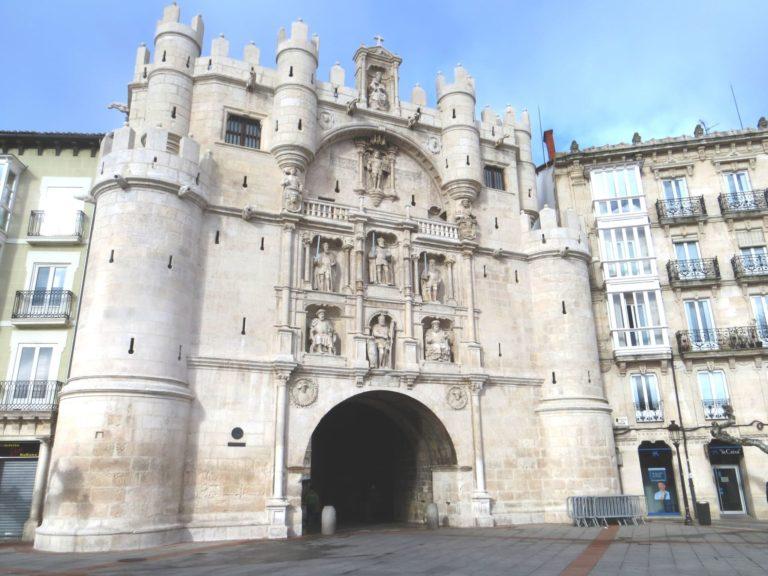1-SAN JUANCOLLECTION OF HISTORIC BUILDINGS
This architectural ensemble, formed by different elements, was declared ‘Conjunto Monumental’ (Historical Monumental Site) in 1944. It is made up of the gate that pilgrims once used as an entrance to the city, the bridge across river Vena, San Lesmes church, Gothic style from the end of the 15th century, with modifications during the 16thcentury, and where the tomb of the patron saint of the city can be found, with beautiful sepulchres and outstanding altarpieces, and also the old monastery of San Juan, founded by king Alfonso VI, which has a large hospital next to it.
2- PLAZA MAYOR
“Plaza de Burgos (…) is huge and doesn’t lack personality. Red coloured houses held upby bluish granite pillars surround it on every corner” With these words, Gautier described the main meeting point of the people of Burgos. As a faithful witness to the city’s expansion process from the flattest plains, it is dominated by the City Hall, which was built at the end of the 18th century. Since then, its surroundings have been updated with new buildings, includingthe “Casa de Mercurio” which was designed in 1907 by Vicente Lampárez with a clear modernist inspiration.
3- HUERTO DEL REY
Such an emotive name reminds us of its origin, linked to the royal residence surrounded by leafy vegetation, that belonged to king Fernando I in the 11th century. At the end of that century, local efforts to clean up the land and provide the area with a water supply resulted in the transformation of its surroundings. Over time it accommodated the residences of many important local families of the 16th and 17th centuries. It was dominated by an original Baroque fountain, dedicated to Flora theRoman Goddess, whois sat on a dolphin with a basket full of flowers, with her voluptuous silhouette which is a promise of abundance and fertility.
4-LAS LLANAS
The Llana de Afuera and Llana de Adentro are two privileged spaces that bear witness to the passing of time in the area of the Cathedral, and clear evidence of the continuing expansion though the flatter areas by a population originally developed on the hills of the castle. Here we can find some of the most emblematic spots of the historical old town, where time seems to stand still, as described perfectly the writer Bonifacio Zamora in 1948 «Llama de Adentro, Llana de Afuera. Flat ground, dark corners and small pebbled squares. Here is where this city snoozes. Here is where it gets old ».
5- CATHEDRAL COMPLEX
“Imagine everything that art can refine, all of this can be found in both the exterior and interior of the church”. With these words theFrench humanist, Muret, described the Cathedral Complex in 1666. It was started in 1221 with the support of King Fernando III “The Saint” and the Bishop Mauricio, with the project becoming more and more sophisticated with the passing of the centuries, gathering together the concerns of all ages. It was managed by many expert masters from different corners of Europe who produced the best works of western art in it.
6- GATE AND TOWER OF SANTA MARÍA
Originally designed as a solid tower that controlled Paseo Espolón, it hosted the meetings of the city council until the end of the 18th century in its majestic“De Poridad” hall.Between 1536 and 1553 a monumental triumphal arch was installed in honour of Emperor Charles V. Francisco de Colonia started its construction which was finished by Juan de Vallejo. It replaced the old gate of San Martin as the public entrance gate of the monarchs, and is nowan exhibition hall, where the remains of Mudejar plasterworks that were originally at the castle and a mural representing Count Fernán González, work of Vela Zanetti, can be seen.
7- CHURCH OF SANTA ÁGUEDA
Located in the street with the same name, the currenttemple dates back to the 15th century, with its beautiful domes from the 16th century, and the inside featuring the interesting funerary sets from the Renaissance. It is built over thewell-known church of Santa Gadea, where El Cid made King Alfonso VI swear that he didn’t play any part in the death of his brother, Sancho II. This act resulted in him being exiled from the kingdom of Castile. In the poem “El Cantar del Mio Cid” this event is told with these words: “In Santa Gadea of Burgos, where the noblemen swore onoath, this is where El Cid swore to the Castilian king over an iron lock and a wooden crossbow.”
8- OLD GRAIN EXCHANGE BUILDING
Builtbetween 1512 and 1514 as a grain warehouse of the city council. It was completely transformed when it became a prison in 1853. From the original building we can see the façade blazoned with the weapons of the city and a large coat of arms flanked by two “maceros”, emblematic characters that had a protocolary role in the duties of the council, carrying maces (mazas in Spanish) with the weapons of the City. Since 1981 it has housed a cultural centre dedicated to the local humanist and musician Francisco Salinas.



